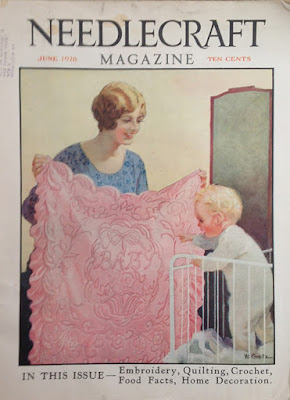A cute if historically inaccurate drawing of two Colonial
ladies quilting in a booklet from Needlecraft Magazine.
There is a little hint of a signature on the frame at the right
Y Pit...
One of the more obscure quilt booklet/catalogs is this Needlecraft Book of Patchwork and Quilting from the Maine magazine probably in the 1920s.
The author was Ethel M. McCunn, not a well-known name in the quilt pattern world of the 1920-1950s.
The 16-page catalog offered patterns that had been printed
in various magazines coming from the same publishing house
in Augusta, Maine.
It looks like Ethel had the artists redraw a few or maybe she drew these herself. We can find out something about her in the newspapers and scanned magazines of the 1920s into the '40s.
Green Bay, early-20th century
Ethel M. McCunn was born in 1885 in Green Bay, Wisconsin, eldest child of John Niven McCunn (1858-1937) and Florence Ida Pipe (1860-1889). Her mother died at 29 when Ethel was 4. Her father remarried twice.
J. N. McCunn, born in Glasgow, Scotland, ran a business school in Green Bay and as a loyal Wisconsin Republican he was appointed a consul to Scotland in 1897 by President McKinley, living in Dunfermline and Glasgow until 1919. Ethel and her siblings moved to Scotland at the turn of the last century. While in Scotland her stepmother died and her father remarried a woman from Glasgow.
Daughter Ethel was fortunate enough to attend art school in Glasgow where she took "a full course in general designing, needle work and pottery."
(Jessie Rowat Newbery, 1864-1948)
We can assume she was a student of Jessie Newbery who was head of the embroidery department at the
Glasgow School of Art from 1894 to 1908 and of her successor Ann McBeth, both of whom were extraordinary embroidery designers.
Ann McBeth (1875-1948)
Ethel then taught art in England and Scotland, according to a biography in the Green Bay Press, which tells us that when she returned to the U.S. she became an embroidery designer for New York's Bernhard Ulmann Company, later Bucilla Needlework.
Perhaps Ethel had a hand in this 1921
Bucilla embroidery pattern book, illustrating the influence
of the Glasgow School of Art
Ethel was an embroidery designer for Pictorial Review and then spent 7 years at "The American Thread Company, managing the art thread department and editing the Star Needlework Journal."
She worked at the American Thread Company building in
what we now call Tribeca.
Editing and probably designing patterns.
In the 1920s she gave radio talks on embroidery.
We aren't just looking at quilt patterns here, we are looking a women's lives and women's work that has gone unnoticed. In the 1920s Ethel was part of an important group of professional women in New York. She was active in the League of Advertising Women. In addition to being a designer and an editor she also saw herself as an advertising professional. In 1926 the association held a costume party where she dressed as an Egyptian.
1948, White Plains Journal News
As the Great Depression ended the publishing heyday of the 1920s we lose track of Ethel, although she might be this woman: Ethel McCunn Walker who owned the Knitting Nook in Nyack, New York in the 1940s and early '50s.
Patchwork and quilts do not seem to be her real interests, which is why we seem to have only one publication from her.
1928 cover signed W Grotz (William Grotz)
A look at Ethel's life gives us a little insight into the early-20th-century needlework press and how women with educations like hers were ready to provide the articles and designs that led to the "Quilt Revival" of the 1925-1950 era.



















No comments:
Post a Comment